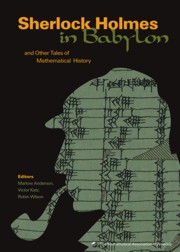Book contents
- Frontmatter
- Introduction
- Contents
- Ancient Mathematics
- Medieval and Renaissance Mathematics
- Foreword
- The Discovery of the Series Formula for π by Leibniz, Gregory and Nilakantha
- Ideas of Calculus in Islam and India
- Was Calculus Invented in India?
- An Early Iterative Method for the Determination of sin 1°
- Leonardo of Pisa and his Liber Quadratorum
- The Algorists vs. the Abacists: An Ancient Controversy on the Use of Calculators
- Sidelights on the Cardan-Tartaglia Controversy
- Reading Bombelli's χ-purgated Algebra
- The First Work on Mathematics Printed in the New World
- Afterword
- The Seventeenth Century
- The Eighteenth Century
- Index
- About the Editors
The Algorists vs. the Abacists: An Ancient Controversy on the Use of Calculators
from Medieval and Renaissance Mathematics
- Frontmatter
- Introduction
- Contents
- Ancient Mathematics
- Medieval and Renaissance Mathematics
- Foreword
- The Discovery of the Series Formula for π by Leibniz, Gregory and Nilakantha
- Ideas of Calculus in Islam and India
- Was Calculus Invented in India?
- An Early Iterative Method for the Determination of sin 1°
- Leonardo of Pisa and his Liber Quadratorum
- The Algorists vs. the Abacists: An Ancient Controversy on the Use of Calculators
- Sidelights on the Cardan-Tartaglia Controversy
- Reading Bombelli's χ-purgated Algebra
- The First Work on Mathematics Printed in the New World
- Afterword
- The Seventeenth Century
- The Eighteenth Century
- Index
- About the Editors
Summary
In 1299 the bankers of Florence were forbidden to use Arabic numerals and were obliged instead to use Roman numerals. And in 1348 the University of Padua directed that a list of books for sale should have the prices marked “non per cifras, sed per literas clara” (not by figures, but by clear letters). [1], [11], [15]
Our “modern” decimal system of notation actually comes to us from ancient India. Some of the symbols in use today were used as early as the third century B.C. (The zero, however, did not appear until much later —about A.D. 376.) The Arabs carried these numerals into Western Europe at the time of the Moorish invasions about A.D. 750. Gerbert, who became Pope Sylvester II toward the end of the tenth century, is the first European scholar who is definitely known to have taught using the Hindu-Arabic numeration system. Yet, three and four hundred years later we find these numerals being outlawed! Hindu-Arabic numerals seem so much more convenient to use than Roman numerals, especially for representing large numbers in a small space, that we might wonder why this system of notation was not readily adopted as soon as it was known. [3], [7], [13]
Since the Greeks of the sixth and fifth centuries B.C. are known to have traveled throughout the ancient world and would certainly have come into contact with positional systems of numeration such as that used by the Babylonians, it seems strange that they did not generally recognize and adopt a numeration system that was more efficient for computation than their own non-positional system.
- Type
- Chapter
- Information
- Sherlock Holmes in BabylonAnd Other Tales of Mathematical History, pp. 148 - 152Publisher: Mathematical Association of AmericaPrint publication year: 2003
- 2
- Cited by

